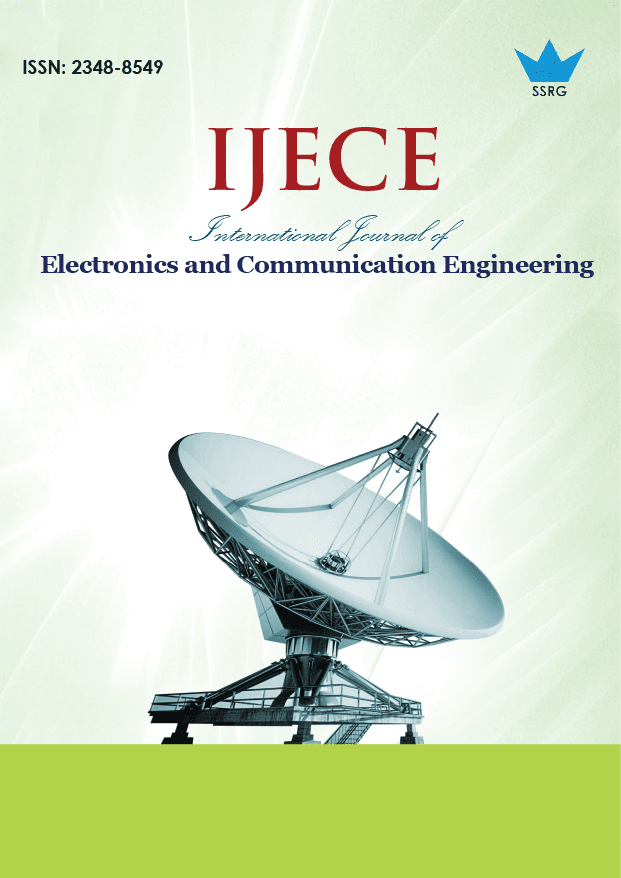Coverage Area Maximization for Multiple UAVs Using Co-Operative Game Theory

| International Journal of Electronics and Communication Engineering |
| © 2025 by SSRG - IJECE Journal |
| Volume 12 Issue 10 |
| Year of Publication : 2025 |
| Authors : Indu, Rishipal Singh |
How to Cite?
Indu, Rishipal Singh, "Coverage Area Maximization for Multiple UAVs Using Co-Operative Game Theory," SSRG International Journal of Electronics and Communication Engineering, vol. 12, no. 10, pp. 27-38, 2025. Crossref, https://doi.org/10.14445/23488549/IJECE-V12I10P104
Abstract:
Unmanned Aerial Vehicles (UAVs) have been gaining popularity with their distinctive features. A multi-UAV network has an advantage over a single UAV, and they can co-operatively accomplish a complex task. Ensuring full coverage of the communication area with the least possible UAV deployment is still underexplored. Non-game theoretic approaches focus on centralized solutions and require constant communication, which is difficult in high mobile UAV communication. Deployment of UAVs in a particular area leads to an increase in interference and therefore reduces network performance. Therefore, in this paper, with the objective of coverage area maximization, a co-operative game theory has been proposed for a multi-UAV scenario in communication with Ground Users (GU). A radio frequency propagation model has been adopted for coverage probability calculation. A Spatial Adaptive Play (SAP) driven algorithm has been formulated for the convergence of the potential game approach to select the game action for the next state. Interference has been mitigated by using the relative distance criterion among UAVs. Nash equilibrium has been proved, and it has been shown that convergence has been reached. Each UAV, according to the co-operative game scenario, tries to maximize utility/payoff. Simulation results demonstrate that the proposed game theory approach is both reliable and effective.
Keywords:
Co-operative Game Theory, Coverage Maximization, Nash Equilibrium, Potential Games, Unmanned Aerial Vehicle.
References:
[1] Mohammad Mozaffari et al., “A Tutorial on UAVs for Wireless Networks: Applications, Challenges, and Open Problems,” IEEE Communications Surveys & Tutorials, vol. 21, no. 3, pp. 2334-2360, 2019.
[CrossRef] [Google Scholar] [Publisher Link]
[2] Yong Zeng, Rui Zhang, and Teng Joon Lim, “Wireless Communications with Unmanned Aerial Vehicles: Opportunities and Challenges,” IEEE Communications Magazine, vol. 54, no. 5, pp. 36-42, 2016.
[CrossRef] [Google Scholar] [Publisher Link]
[3] Sina Sharif Mansouri et al., “Cooperative Coverage Path Planning for Visual Inspection,” Control Engineering Practice, vol. 74, pp. 118-131, 2018.
[CrossRef] [Google Scholar] [Publisher Link]
[4] Marcelo S. Menegol, Jomi F. Hübner, and Leandro B. Becker, “Coordinated UAV Search and Rescue Application with JaCaMo,” Advances in Practical Applications of Agents, Multi-Agent Systems, and Complexity: The PAAMS Collection: 16th International Conference, PAAMS, Toledo, Spain, pp. 335-338, 2018.
[CrossRef] [Google Scholar] [Publisher Link]
[5] Sarmad Rashed, and Mujdat Soyturk, “Analyzing the Effects of UAV Mobility Patterns on Data Collection in Wireless Sensor Networks,” Sensors, vol. 17, no. 2, pp. 1-21, 2017.
[CrossRef] [Google Scholar] [Publisher Link]
[6] Jianjun Ni et al., “An Improved Potential Game Theory based Method for Multi-UAV Cooperative Search,” IEEE Access, vol. 8, pp. 47787-47796, 2020.
[CrossRef] [Google Scholar] [Publisher Link]
[7] Simran Singh et al., “Intelligent Interference Management in UAV-Based HetNets,” Telecom, vol. 2, no. 4, pp. 472-488, 2021.
[CrossRef] [Google Scholar] [Publisher Link]
[8] John Peterson et al., “Experiments in Unmanned Aerial Vehicle/Unmanned Ground Vehicle Radiation Search,” Journal of Field Robotics, vol. 36, no. 4, pp. 818-845, 2019.
[CrossRef] [Google Scholar] [Publisher Link]
[9] Mbazingwa Elirehema Mkiramweni et al., “A Survey of Game Theory in Unmanned Aerial Vehicles Communications,” IEEE Communications Surveys & Tutorials, vol. 21, no. 4, pp. 3386-3416, 2019.
[CrossRef] [Google Scholar] [Publisher Link]
[10] Akram Al-Hourani, Sithamparanathan Kandeepan, and Simon Lardner, “Optimal LAP Altitude for Maximum Coverage,” IEEE Wireless Communications Letters, vol. 3, no. 6, pp. 569-572, 2014.
[CrossRef] [Google Scholar] [Publisher Link]
[11] Mohamed Alzenad et al., “3-D Placement of an Unmanned Aerial Vehicle Base Station (UAV-BS) for Energy-Efficient Maximal Coverage,” IEEE Wireless Communications Letters, vol. 6, no. 4, pp. 44-437, 2017.
[CrossRef] [Google Scholar] [Publisher Link]
[12] Nesrine Cherif et al., “On the Optimal 3D Placement of a UAV Base Station for Maximal Coverage of UAV Users,” GLOBECOM 2020 - 2020 IEEE Global Communications Conference, Taipei, Taiwan, pp. 1-6, 2020.
[CrossRef] [Google Scholar] [Publisher Link]
[13] Mohammad Mozaffari et al., “Efficient Deployment of Multiple Unmanned Aerial Vehicles for Optimal Wireless Coverage,” IEEE Communications Letters, vol. 20, no. 8, pp. 1647-1650, 2016.
[CrossRef] [Google Scholar] [Publisher Link]
[14] Taifei Zhao, Hua Wang, and Qianwen Ma, “The Coverage Method of Unmanned Aerial Vehicle Mounted base Station Sensor Network based on Relative Distance,” International Journal of Distributed Sensor Networks, vol. 16, no. 5, pp. 1-12, 2020.
[CrossRef] [Google Scholar] [Publisher Link]
[15] Nima Namvar et al., “Heterogeneous UAV Cells: An Effective Resource Allocation Scheme for Maximum Coverage Performance,” IEEE Access, vol. 7, pp. 164708-164719, 2019.
[CrossRef] [Google Scholar] [Publisher Link]
[16] Philip B. Charlesworth, “Using Non-Cooperative Games to Coordinate Communications UAVs,” 2014 IEEE Globecom Workshops (GC Wkshps), Austin, TX, USA, pp. 1463-1468, 2014.
[CrossRef] [Google Scholar] [Publisher Link]
[17] Sara Koulali et al., “A Green Strategic Activity Scheduling for UAV Networks: A Sub-Modular Game Perspective,” IEEE Communications Magazine, vol. 54, no. 5, pp. 58-64, 2016.
[CrossRef] [Google Scholar] [Publisher Link]
[18] Ibrahim A. Nemer, Tarek R. Sheltami, and Ashraf S. Mahmoud, “A Game Theoretic Approach of Deployment a Multiple UAVs for Optimal Coverage,” Transportation Research Part A: Policy and Practice, vol. 140, pp. 215-230, 2020.
[CrossRef] [Google Scholar] [Publisher Link]
[19] Lang Ruan et al., “A Coalition Formation Game Approach for Efficient Cooperative Multi-UAV Deployment,” Applied Sciences, vol. 8, no. 12, pp. 1-16, 2018.
[CrossRef] [Google Scholar] [Publisher Link]
[20] Lang Ruan et al., “Energy-Efficient Multi-UAV Coverage Deployment in UAV Networks: A Game-Theoretic Framework,” China Communications, vol. 15, no. 10, pp. 194-209, 2018.
[CrossRef] [Google Scholar] [Publisher Link]
[21] Yifan Xu et al., “A One-Leader Multi-Follower Bayesian-Stackelberg Game for Anti-Jamming Transmission in UAV Communication Networks,” IEEE Access, vol. 6, pp. 21697-21709, 2018.
[CrossRef] [Google Scholar] [Publisher Link]
[22] Akram Al-Hourani, Sithamparanathan Kandeepan, and Abbas Jamalipour, “Modeling Air-to-Ground Path Loss for Low Altitude Platforms in Urban Environments,” 2014 IEEE Global Communications Conference, Austin, TX, USA, pp. 2898-2904, 2014.
[CrossRef] [Google Scholar] [Publisher Link]
[23] Qixinf Feng et al., “Path Loss Models for Air-to-Ground Radio Channels in Urban Environments,” 2006 IEEE 63rd Vehicular Technology Conference, Melbourne, VIC, Australia, pp. 2901-2905. 2006.
[CrossRef] [Google Scholar] [Publisher Link]
[24] Kiran Venugopal, Matthew C. Valenti, and Robert W. Heath, “Device-to-Device Millimeter Wave Communications: Interference, Coverage, Rate, and Finite Topologies,” IEEE Transactions on Wireless Communications, vol. 15, no. 9, pp. 6175-6188, 2016.
[CrossRef] [Google Scholar] [Publisher Link]
[25] Yuhua Xu et al., “Opportunistic Spectrum Access in Cognitive Radio Networks: Global Optimization using Local Interaction Games,” IEEE Journal of Selected Topics in Signal Processing, vol. 6, no. 2, pp. 180-194, 2011.
[CrossRef] [Google Scholar] [Publisher Link]
[26] Dov Monderer, and Lloyd S. Shapley, “Potential Games,” Games and Economic Behavior, vol. 14, no. 1, pp. 124-143, 1996.
[CrossRef] [Google Scholar] [Publisher Link]
[27] H. Peyton Young, Individual Strategy and Social Structure An Evolutionary Theory of Institutions, Princeton University Press, pp. 1-189, 2020.
[Google Scholar] [Publisher Link]
[28] Gürdal Arslan, Jason R. Marden, and Jeff S. Shamma, “Autonomous Vehicle-Target Assignment: A Game-Theoretical Formulation,” Journal of Dynamic Systems, Measurement, and Control, vol. 129, no. 5, pp. 584-596, 2007.
[CrossRef] [Google Scholar] [Publisher Link]
[29] Chandramani K. Singh, and Chung Shue Chen, “Distributed Downlink Resource Allocation in Cellular Networks through Spatial Adaptive Play,” Proceedings of the 2013 25th International Teletraffic Congress (ITC), Shanghai, China, pp. 1-9, 2013.
[CrossRef] [Google Scholar] [Publisher Link]
[30] Nikolaos Bousias et al., “Collaborative Visual Area Coverage Using Aerial Agents Equipped with PTZ-Cameras Under Localization Uncertainty,” 2019 18th European Control Conference (ECC), Naples, Italy, pp. 1079-1084, 2019.
[CrossRef] [Google Scholar] [Publisher Link]

 10.14445/23488549/IJECE-V12I10P104
10.14445/23488549/IJECE-V12I10P104